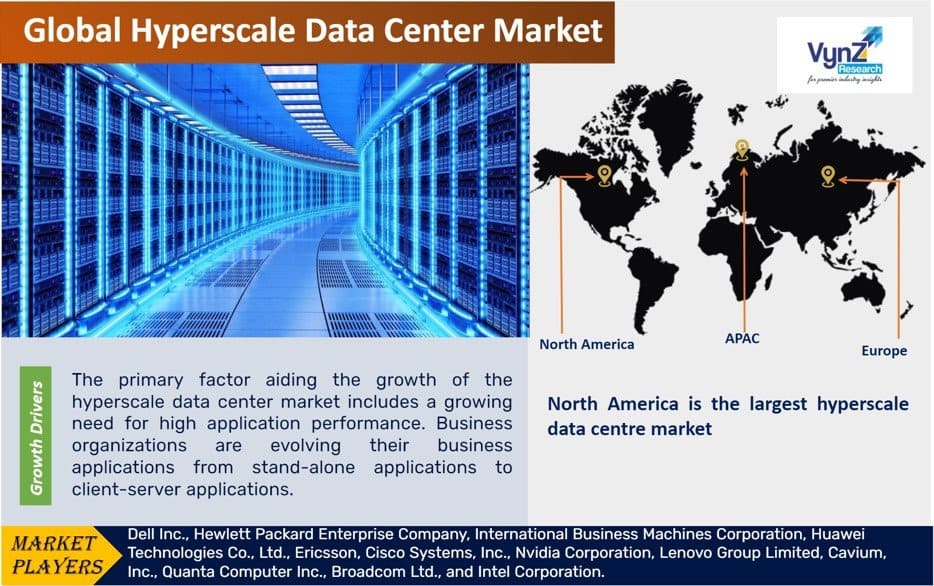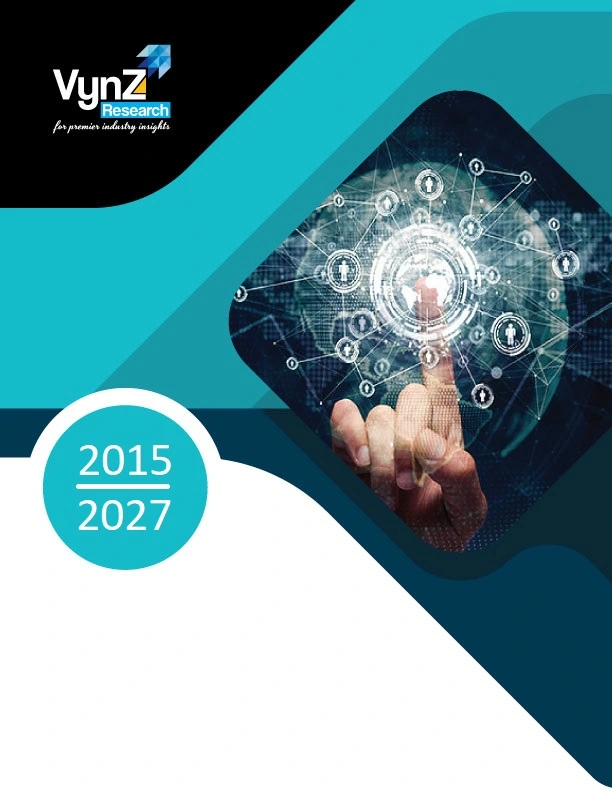Industry Overview
The global Hyperscale Data Center market is expected to grow from USD 101.23 billion in 2023 to USD 130.98 billion during the forecast period, clocking a CAGR of about 5.29%.
The most significant reason for the growth of the global Hyperscale Data Center market is that it offers users a single and scalable architecture. This will help the data centers process and store a large volume of commercial data and consumer information.
It is also helping modern businesses a great deal enabling them to use enterprise-level mobile applications, a crucial requirement for modern business models. This has made large hyperscale data centers that are managed by Google, Amazon, and Facebook to increase their efficiency and performance.
It is due to the efficient architecture that is made up of several small independent servers, called nodes that are usually deployed from off-the-shelf, inexpensive servers. These nodes facilitate data processing, storing, and networking, all from a single and scalable architecture that is then grouped and managed like a single entity.

Hyperscale Data Center Market Segmentation
Insight by Component
According to the component, the global Hyperscale Data Center market is divided into solutions and services.
Out of these two segments, the services category, which is further divided into deployment, installation, support, maintenance, and consulting will grow at a faster rate during the forecast period mainly because most enterprises will look for efficient services that will help in evolving their business operations and applications from stand-alone applications to client-server applications.
As for the solution segment, it is further divided into server, storage, server, networking, and software.
Insight by Data Center Size
According to the size of the data centers, the global Hyperscale Data Center market is divided into small and medium-sized data centers and large data centers.
Out of these two categories, the small and medium-sized data centers are expected to grow at a faster rate during the forecast period. This is due to the additional focus on the industry players on small and medium-sized companies to provide the infrastructure.
Insight by End User
The global Hyperscale Data Center market comprises different end users, such as cloud providers, colocation providers, and enterprises.
Out of these, the cloud providers will grow at a faster rate than others during the forecast period due to the lack of robust infrastructure and the rise in popularity of such services and their use to store data.
Insight by Industry
According to the industry, the global Hyperscale Data Center market can be divided into IT, BFSI, telecom, manufacturing, research, academics, defense, government, retail, healthcare, media, and entertainment.
Out of all these categories, the healthcare and life sciences sector will witness higher growth during the analysis period due to the rising demand and adoption of HER, CDSS solutions, and different data analysis and management for healthcare. This leads to the need for a better infrastructure for networking and data storage in the healthcare industry.
Global Hyperscale Data Center Market Report Coverage
|
Report Metric
|
Details
|
|
Historical Period
|
2018 - 2023
|
|
Base Year Considered
|
2024
|
|
Forecast Period
|
2025 - 2030
|
|
Market Size in 2024
|
U.S.D. 101.23 Billion
|
|
Revenue Forecast in 2030
|
U.S.D. 130.98 Billion
|
|
Growth Rate
|
5.29%
|
|
Segments Covered in the Report
|
By Component, By Data Center Size, By End User, and By Industry
|
|
Report Scope
|
Market Trends, Drivers, and Restraints; Revenue Estimation and Forecast; Segmentation Analysis; Impact of COVID-19; Companies’ Strategic Developments; Market Share Analysis of Key Players; Company Profiling
|
|
Regions Covered in the Report
|
North America, Europe, Asia-Pacific, Middle East, and Rest of the World
|
Industry Dynamics
Hyperscale Data Center Market Growth Drivers
The rise in demand for better applications and their performance is one significant growth driver of the global Hyperscale Data Center market. This includes everything from stand-alone to client-server applications, and from distributed applications to cloud-based elastic applications. With the use of this infrastructure, businesses can manage application performance and ensure proper functioning.
Also, there has been an increase in the demand for digital transformation and cloud services in recent years. Along with that, there is an increase in the spread of data-intensive applications. All these and the rise of technologies such as edge computing, the Internet of Things, and 5G networks have propelled the growth of the global Hyperscale Data Center market as it facilitates processing and storing huge amounts of data closer to end users.
The use of technology helps in increasing the sales and revenue of a business. So, with the use of a large number of applications, the performance of businesses is significantly improved especially when they want to expand their global presence and market. This architecture offers business continuity and helps them achieve these goals through better user experience and customer satisfaction.
Hyperscale Data Center Market Opportunity
Opportunities for the growth of the global Hyperscale Data Center market are created mainly due to the increase in data center traffic, which, in turn, increases the demand for data storage.
Most businesses today source their computing data to the cloud-based setup and therefore these service providers implement the hyperscale data centers to store such large amounts of data. This offers easy accessibility and computation of data.
Hyperscale Data Center Market Challenges
The most significant challenges to the global Hyperscale Data Center market are energy consumption, impact on the environment, and sustainability. The high-power requirements usually raise carbon footprint.
However, efforts are made continuously to overcome these hurdles by opting for renewable energy sources and advanced cooling technologies. Moreover, DCIM or Data Center Infrastructure Management solutions also help in addressing these challenges.
Hyperscale Data Center Market Geographic Overview
North America is the largest contributor to the global Hyperscale Data Center market due to the high demand for it in this region. This growing demand is attributed to its robust infrastructure, growing awareness about the benefits of this technology among business enterprises, and higher demand for it in specific sectors such as IT, telecom, BFSI, and healthcare.
The Asia-Pacific region is also expected to grow at a fast rate during the forecast period due to the growing demand for cloud services among small, medium, and large enterprises. Other factors such as increased adoption of this architecture by several industries and rapid development in the banking sector also fuel the growth of the global Hyperscale Data Center market in countries like India, China, and Japan.
Hyperscale Data Center Market Competitive Insight
Some of the key players operating in the hyperscale data centre industry are Dell Inc., Hewlett Packard Enterprise Company, International Business Machines Corporation, Huawei Technologies Co., Ltd., Ericsson, Cisco Systems, Inc., Nvidia Corporation, Lenovo Group Limited, Cavium, Inc., Quanta Computer Inc., Broadcom Ltd., and Intel Corporation.
Recent Developments by Key Players
Huawei GreenBay has collaborated with Solarvest and Centexs. This partnership represents a significant stride toward nurturing the hyperscale green data center industry within the Borneo region.
GPU giant Nvidia has launched a new business unit focused on designing custom chips for clients including the cloud hyperscalers. Nvidia is also targeting automotive, telecoms and video game customers. It is reportedly working with telecoms OEM Ericsson for a wireless chip that build on GPU-based technology.



